A Novel Cooperative Navigation Algorithm Based on Factor Graph and Lie Group for AUVs
Abstract
1. Introduction
1.1. Filter-Based CN Algorithms
1.2. Graph Theory-Based CN Algorithms
1.3. Optimization Theory-Based Cooperative Navigation Algorithms
- (1)
- Novel State Representation: Unlike existing factor graph-based CN methods [17,18,19,20,21,22,23] that typically represent the AUV state in vector space (e.g., , this work is the first to utilize the two-dimensional Special Euclidean Group SE(2) from Lie theory to describe the motion state of AUVs. This representation provides a more natural framework for handling the rigid-body motions of AUVs.
- (2)
- Dual-Mode Optimization Framework: We propose two distinct optimization methods tailored for different operational configurations. Method 1 is designed for parallel configurations where all AUVs possess similar sensor accuracy. Method 2 is specifically tailored for leader-slave configurations, which strategically leverages the high-precision attitude information from a well-equipped leader AUV, preventing the degradation of its attitude estimate by noisy acoustic measurements—a common issue in standard EKF or single-method factor graph approaches.
- (3)
- Comprehensive Performance Validation: A parameter-level simulation system that incorporates AUV dynamics is established for evaluation. The proposed methods demonstrate superior performance compared to the conventional EKF, with significant reductions in average RMSE for both parallel (29% reduction with Method 1) and leader-slave (38% reduction with Method 2) configurations.
2. Structures and Devices of Multiple AUVs
2.1. Parallel Configuration
2.2. Leader-Slave Configuration
3. Factor Graph Optimization Theory
4. Modeling Based on Li Group
4.1. Model Design
4.2. Observation Model Based on Li Group
4.2.1. Motion Model
4.2.2. Range and Bearing Model
4.3. System Structure of Factor Graph
4.4. Method of Solving Factor Graph
4.5. AUV Cooperative Navigation Simulation System
5. Experiments and Results
5.1. Experimental Setup
5.2. Simulation Result of Parallel Configuration
5.3. Simulation Result of Leader-Slave Configuration
6. Conclusions
Author Contributions
Funding
Data Availability Statement
Conflicts of Interest
References
- Qi, C.; Ma, T.; Li, Y.; Ling, Y.; Liao, Y.; Jiang, Y. A Multi-AUV Collaborative Mapping System With Bathymetric Cooperative Active SLAM Algorithm. IEEE Internet Things J. 2024, 12, 12441–12452. [Google Scholar] [CrossRef]
- Yoon, S.; Qiao, C. Cooperative search and survey using autonomous underwater vehicles (AUVs). IEEE Trans. Parallel Distrib. Syst. 2010, 22, 364–379. [Google Scholar] [CrossRef]
- Zhao, Z.; Hu, Q.; Feng, H.; Feng, X.; Su, W. A cooperative hunting method for multi-AUV swarm in underwater weak information environment with obstacles. J. Mar. Sci. Eng. 2022, 10, 1266. [Google Scholar] [CrossRef]
- Leblond, I.; Tauvry, S.; Pinto, M. Sonar image registration for swarm AUVs navigation: Results from SWARMs project. J. Comput. Sci. 2019, 36, 101021. [Google Scholar] [CrossRef]
- Wang, C.; Mei, D.; Wang, Y.; Yu, X.; Sun, W.; Wang, D.; Chen, J. Task allocation for Multi-AUV system: A review. Ocean Eng. 2022, 266, 112911. [Google Scholar] [CrossRef]
- Zhang, L.; Yang, J.; Fan, H.; Yang, G. Angle-Constrained Cooperative Guidance Law with Limited Communication for Multi-AUV. In Proceedings of the 2024 10th International Conference on Mechanical and Electronics Engineering (ICMEE), Xi’an, China, 27–29 December; IEEE: Washington, DC, USA, 2024; pp. 1–6. [Google Scholar]
- Wang, Q.; Xu, X.; Cai, M.; Liu, K. Master-slave AUV cooperative navigation algorithm based on nonlinear error compensation of observation matrix. Meas. Sci. Technol. 2025, 36, 076312. [Google Scholar] [CrossRef]
- Liu, X.; Sun, B.; Su, Z. Multi-mode fault-tolerant trajectory tracking control of AUV under thruster failure conditions in complex environments. Ocean Eng. 2025, 330, 121257. [Google Scholar] [CrossRef]
- Harris, Z.J.; Whitcomb, L.L. Preliminary study of cooperative navigation of underwater vehicles without a DVL utilizing range and range-rate observations. In Cooperative Localization and Navigation; CRC Press: Boca Raton, FL, USA, 2019; pp. 161–172. [Google Scholar]
- Gao, W.; Liu, Y.; Xu, B. Robust Huber-based iterated divided difference filtering with application to cooperative localization of autonomous underwater vehicles. Sensors 2014, 14, 24523–24542. [Google Scholar] [CrossRef]
- Zhao, Y.; Xing, W.; Yuan, H.; Shi, P. A collaborative control framework with multi-leaders for AUVs based on unscented particle filter. J. Frankl. Inst. 2016, 353, 657–669. [Google Scholar] [CrossRef]
- Huang, Y.; Zhang, Y.; Xu, B.; Wu, Z.; Chambers, J.A. A new adaptive extended Kalman filter for cooperative localization. IEEE Trans. Aerosp. Electron. Syst. 2017, 54, 353–368. [Google Scholar] [CrossRef]
- Zhang, F.; Wu, X.; Ma, P. Consistent extended Kalman filter-based cooperative localization of multiple autonomous underwater vehicles. Sensors 2022, 22, 4563. [Google Scholar] [CrossRef]
- Kim, J. Cooperative localization and unknown currents estimation using multiple autonomous underwater vehicles. IEEE Robot. Autom. Lett. 2020, 5, 2365–2371. [Google Scholar] [CrossRef]
- Li, Q.; Ben, Y.; Naqvi, S.M.; Neasham, J.A.; Chambers, J.A. Robust student’s t-based cooperative navigation for autonomous underwater vehicles. IEEE Trans. Instrum. Meas. 2018, 67, 1762–1777. [Google Scholar] [CrossRef]
- Zhu, Z.; Duan, Y.; Mu, X.; Bai, G.; Dou, L. An Improved Cooperative Navigation Method for Slave AUV Under the Influence of Ocean Currents. In Proceedings of the 2024 IEEE International Conference on Unmanned Systems (ICUS), Nanjing, China, 18–20 October 2024; IEEE: Washington, DC, USA, 2024; pp. 1590–1596. [Google Scholar]
- Fan, S.; Zhang, Y.; Yu, C.; Zhu, M.; Yu, F. An advanced cooperative positioning algorithm based on improved factor graph and sum-product theory for multiple AUVs. IEEE Access 2019, 7, 67006–67017. [Google Scholar] [CrossRef]
- Ben, Y.; Sun, Y.; Li, Q.; Zang, X. A novel cooperative navigation algorithm based on factor graph with cycles for AUVs. Ocean Eng. 2021, 241, 110024. [Google Scholar] [CrossRef]
- Ma, X.; Li, C. Research on AUVs Parallel Cooperative Navigation and Positioning Technology Based on Factor Graph. In Proceedings of the 2024 18th International Conference on Ubiquitous Information Management and Communication (IMCOM), Kuala Lumpur, Malaysia, 3–5 January 2024; IEEE: Washington, DC, USA, 2024; pp. 1–7. [Google Scholar]
- Li, Y.; Yu, W.; Guan, X. Hybrid TOA-AOA cooperative localization for multiple AUVs in the absence of anchors. IEEE Trans. Ind. Inform. 2023, 20, 2420–2431. [Google Scholar] [CrossRef]
- Li, Q.; Huang, H.; Sun, Y.; Ben, Y. A Factor Graph with Mercator Projection-Based Cooperative Localization Algorithm for Multiple AUVs. IEEE Trans. Instrum. Meas. 2025, 74, 8510810. [Google Scholar] [CrossRef]
- Guo, Q.; Yan, X.; Luo, Q.; Lin, J. Cooperative Localization Algorithm for Multiple AUVs Under Communication Delay. In Proceedings of the 2025 International Wireless Communications and Mobile Computing (IWCMC), Abu Dhabi, United Arab Emirates, 12–16 May 2025; IEEE: Washington, DC, USA, 2025; pp. 31–36. [Google Scholar]
- Ben, Y.; Sun, Y.; Li, Q.; Huang, H.; Gong, S. Multi-AUV cooperative navigation algorithm based on factor graph with stretching nodes strategy. IEEE Trans. Instrum. Meas. 2024, 73, 1008715. [Google Scholar] [CrossRef]
- Zhang, L.; Li, Y.; Liu, L.; Tao, X. Cooperative navigation based on cross entropy: Dual leaders. IEEE Access. 2019, 7, 151378–151388. [Google Scholar] [CrossRef]
- Nerurkar, E.D.; Roumeliotis, S.I.; Martinelli, A. Distributed Maximum a Posteriori Estimation for Multi-Robot Cooperative Localization. In Proceedings of the 2009 IEEE International Conference on Robotics and Automation, Kobe, Japan, 12–17 May 2009; IEEE: Washington, DC, USA, 2009; pp. 1402–1409. [Google Scholar]
- Zhou, L.; Wang, M.; Zhang, X.; Qin, P.; He, B. Adaptive slam methodology based on simulated annealing particle swarm optimization for auv navigation. Electronics 2023, 12, 2372. [Google Scholar] [CrossRef]
- Bo, X.; Razzaqi, A.A.; Yalong, L. Cooperative localisation of AUVs based on Huber-based robust algorithm and adaptive noise estimation. J. Navig. 2019, 72, 875–893. [Google Scholar] [CrossRef]
- Zhu, Z.; Zhang, L.; Liu, L.; Wu, D.; Bai, S.; Ren, R.; Geng, W. An efficient multi-AUV cooperative navigation method based on hierarchical reinforcement learning. J. Mar. Sci. Eng. 2023, 11, 1863. [Google Scholar] [CrossRef]
- Thrun, S. Probabilistic robotics. Commun. ACM 2002, 45, 52–57. [Google Scholar] [CrossRef]
- Barfoot, T.D. State Estimation for Robotics; Cambridge University Press: Cambridge, UK, 2024. [Google Scholar]
- Prestero, T.T.J. Verification of a Six-Degree of Freedom Simulation Model for the REMUS Autonomous Underwater Vehicle; Massachusetts Institute of Technology: Cambridge, MA, USA, 2001. [Google Scholar]
- Gelb, A. Applied Optimal Estimation; MIT Press: Cambridge, MA, USA, 1974. [Google Scholar]
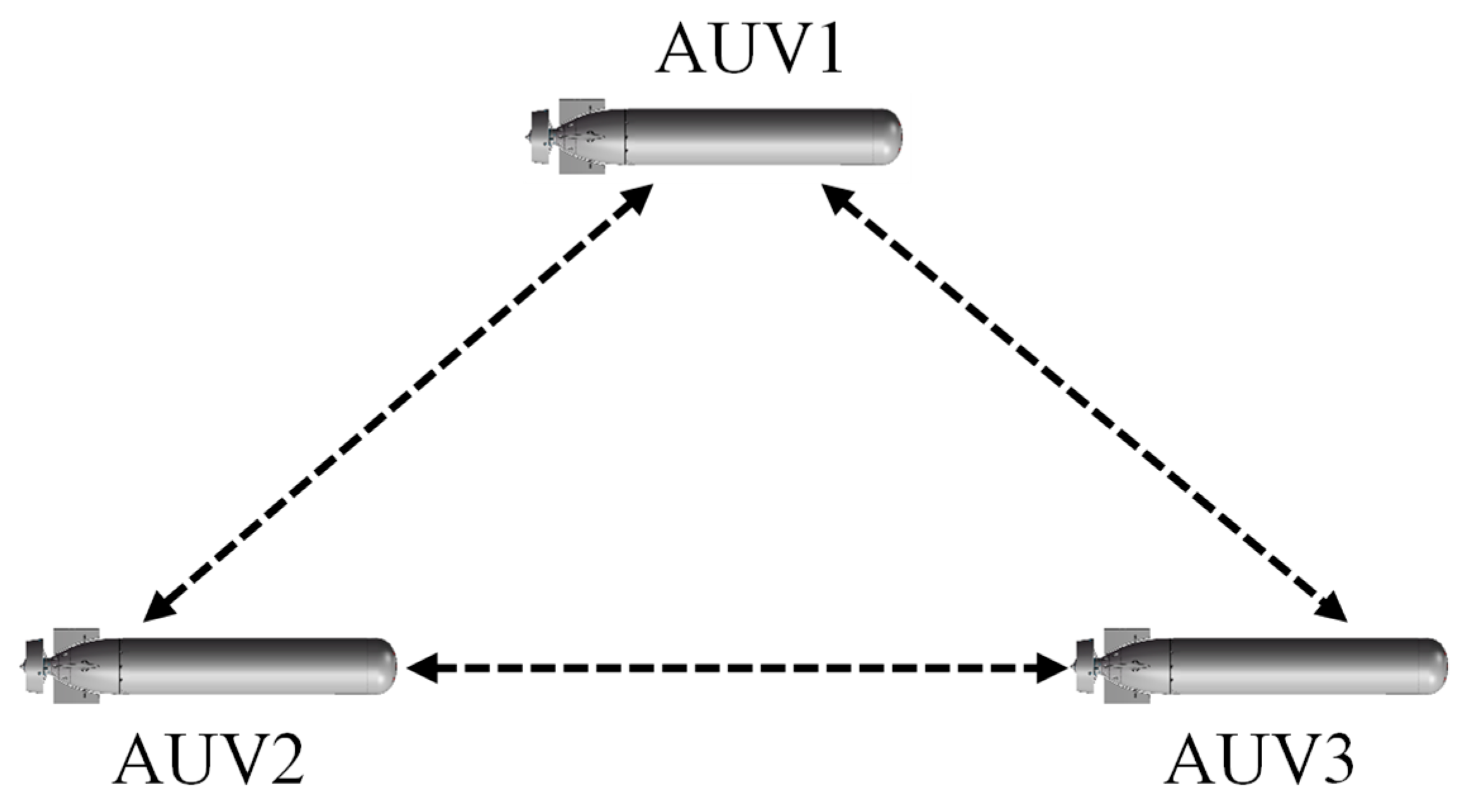
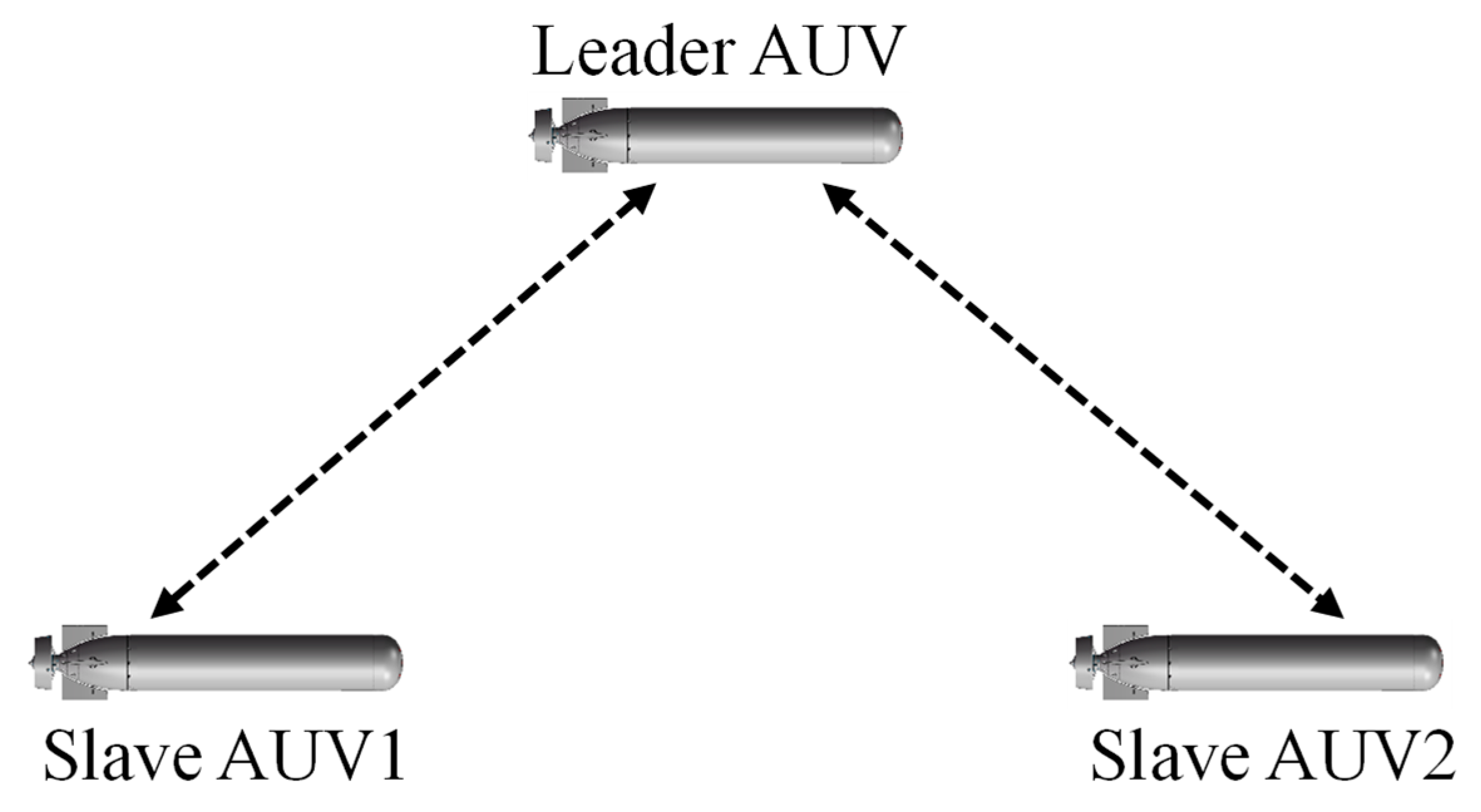
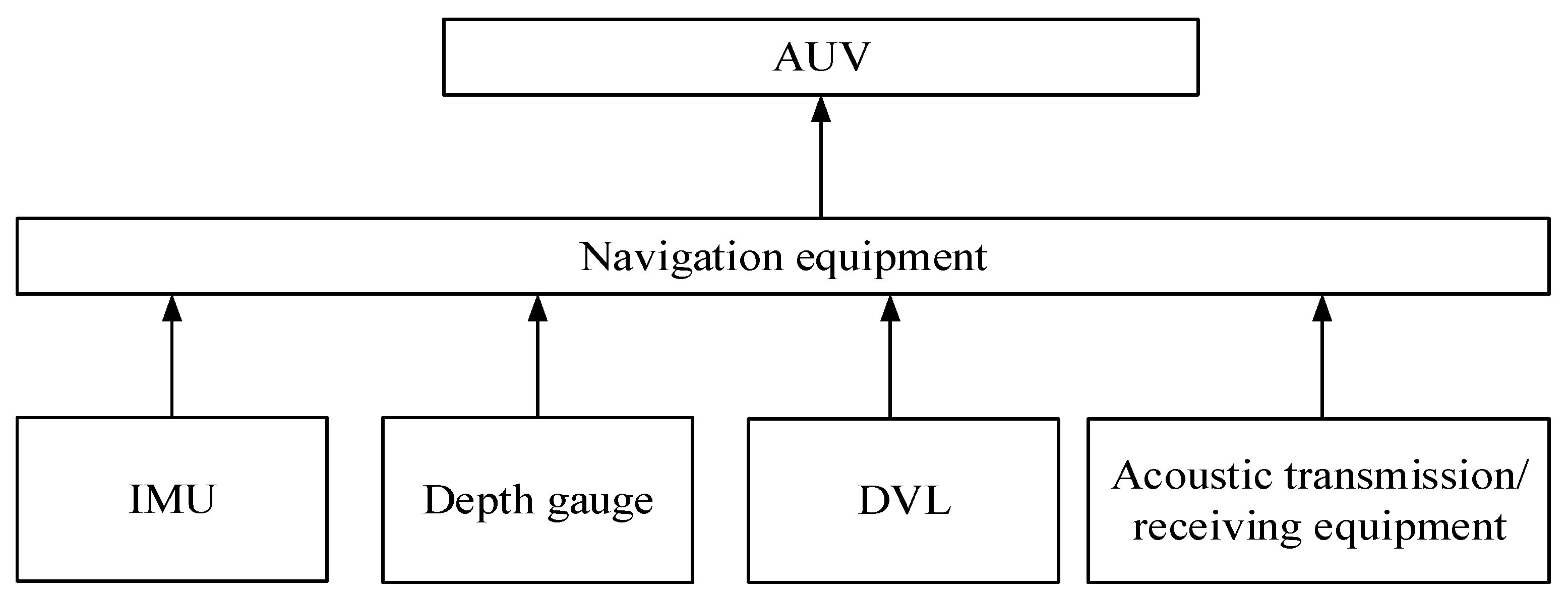
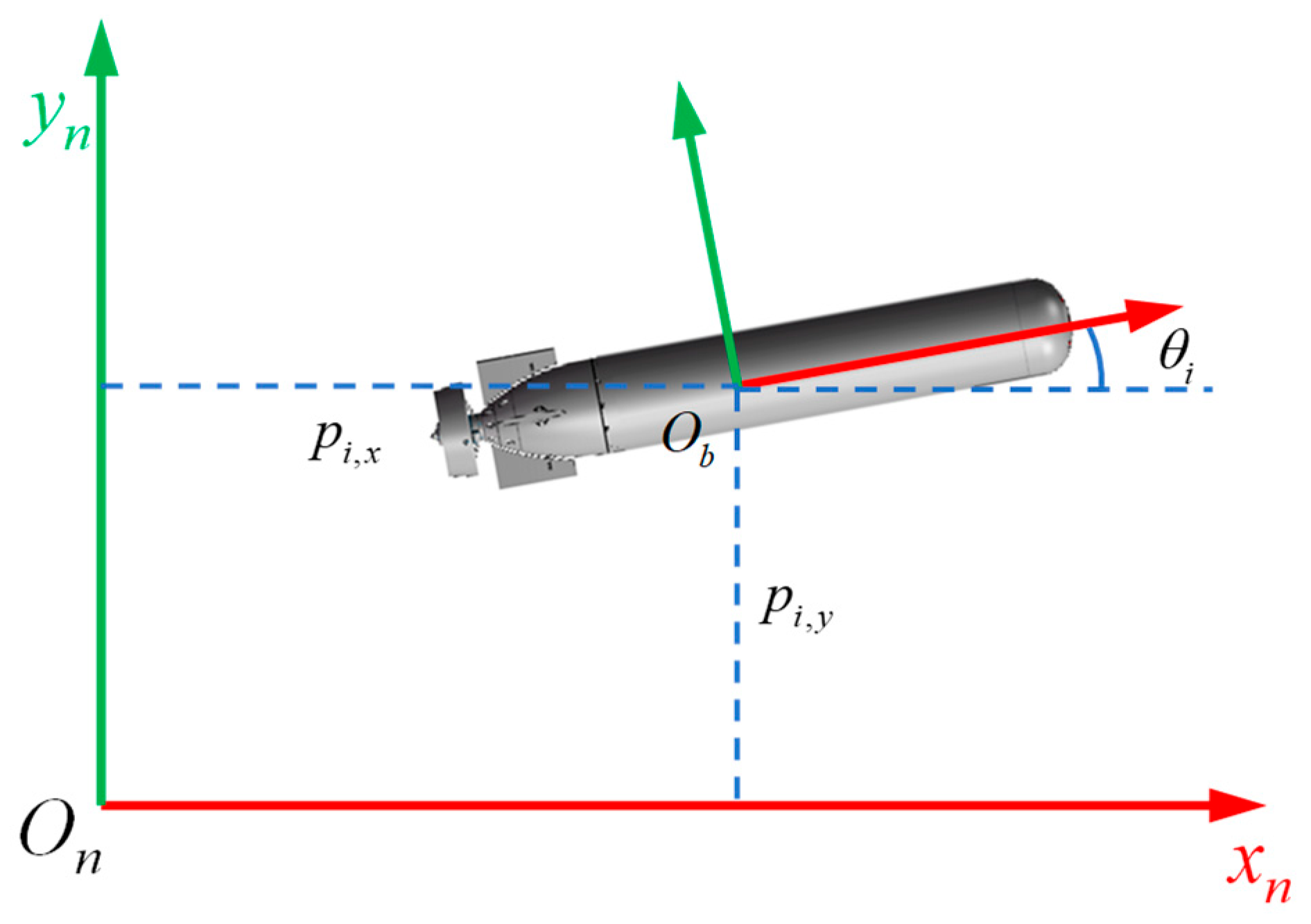
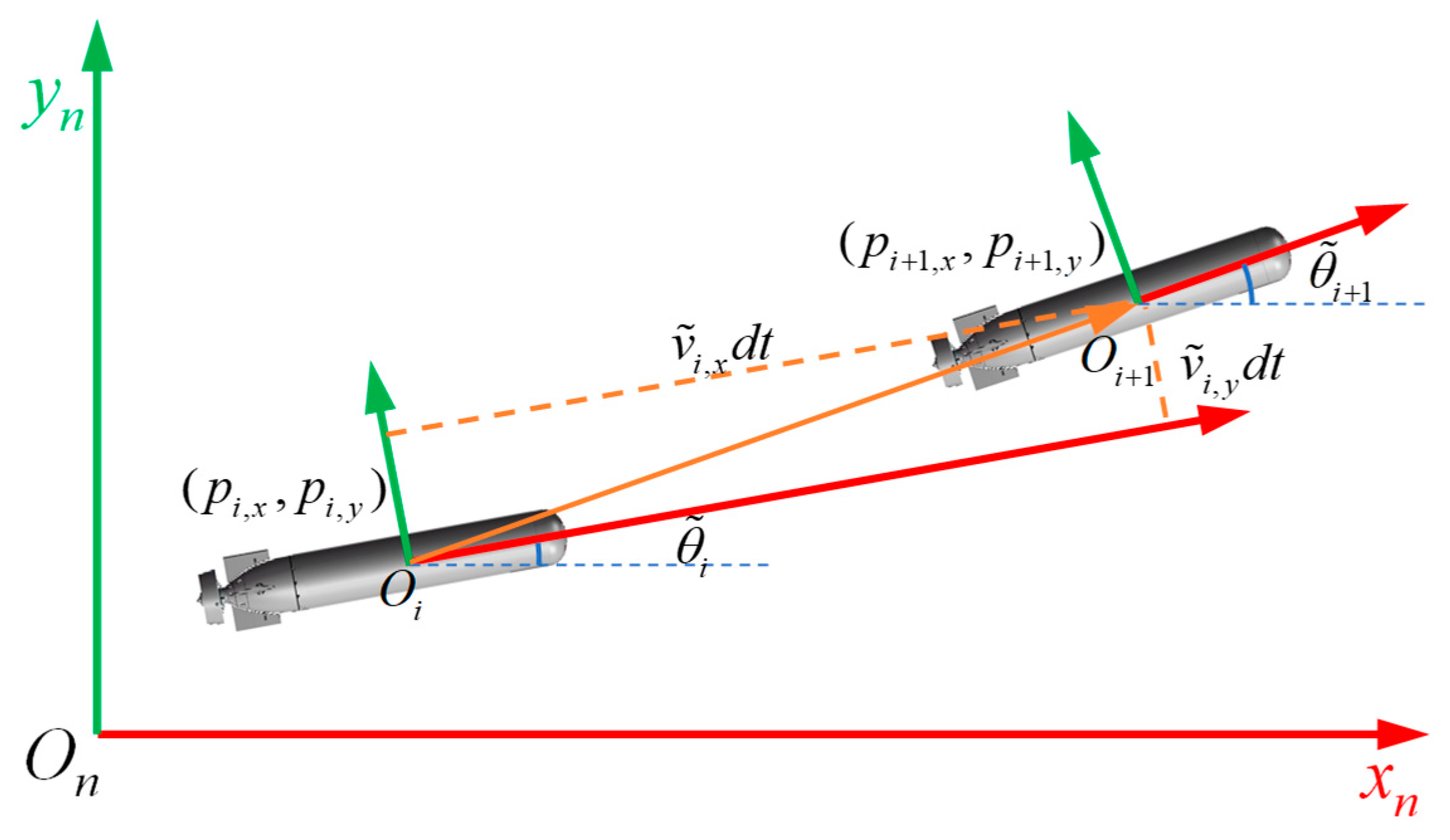

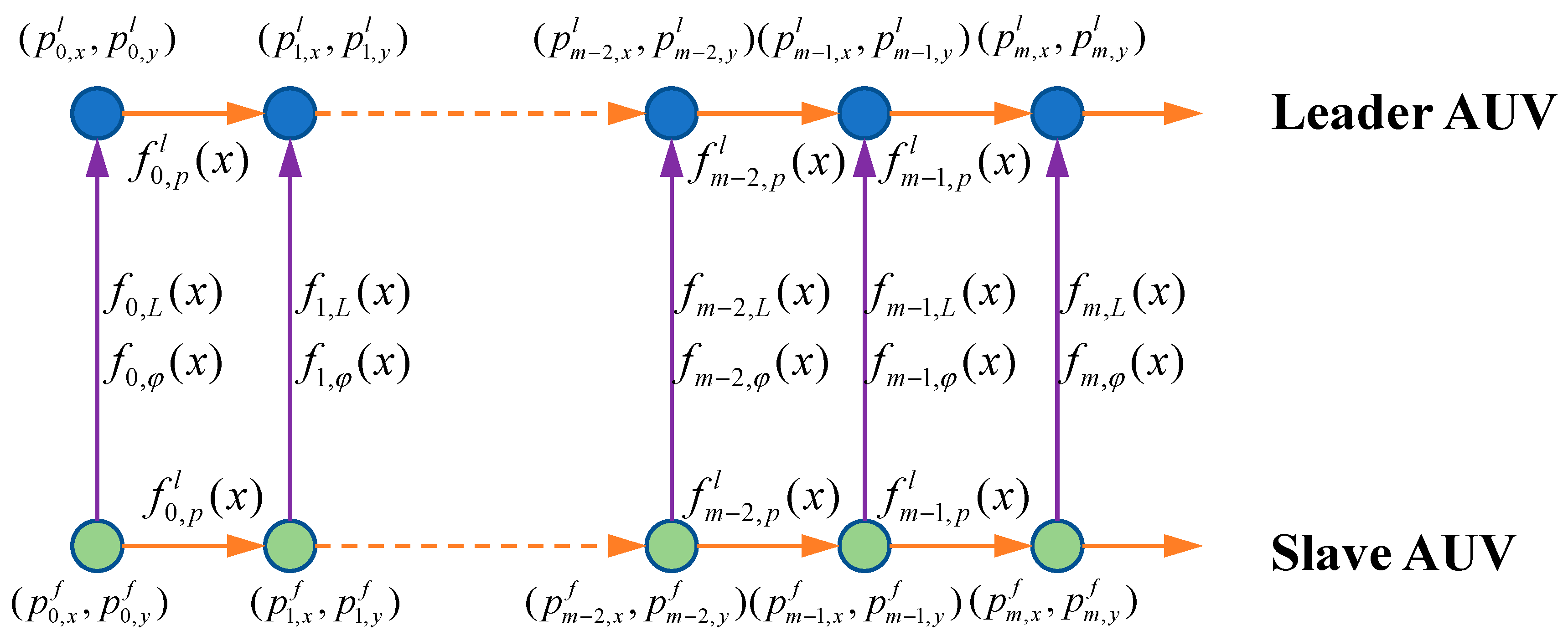
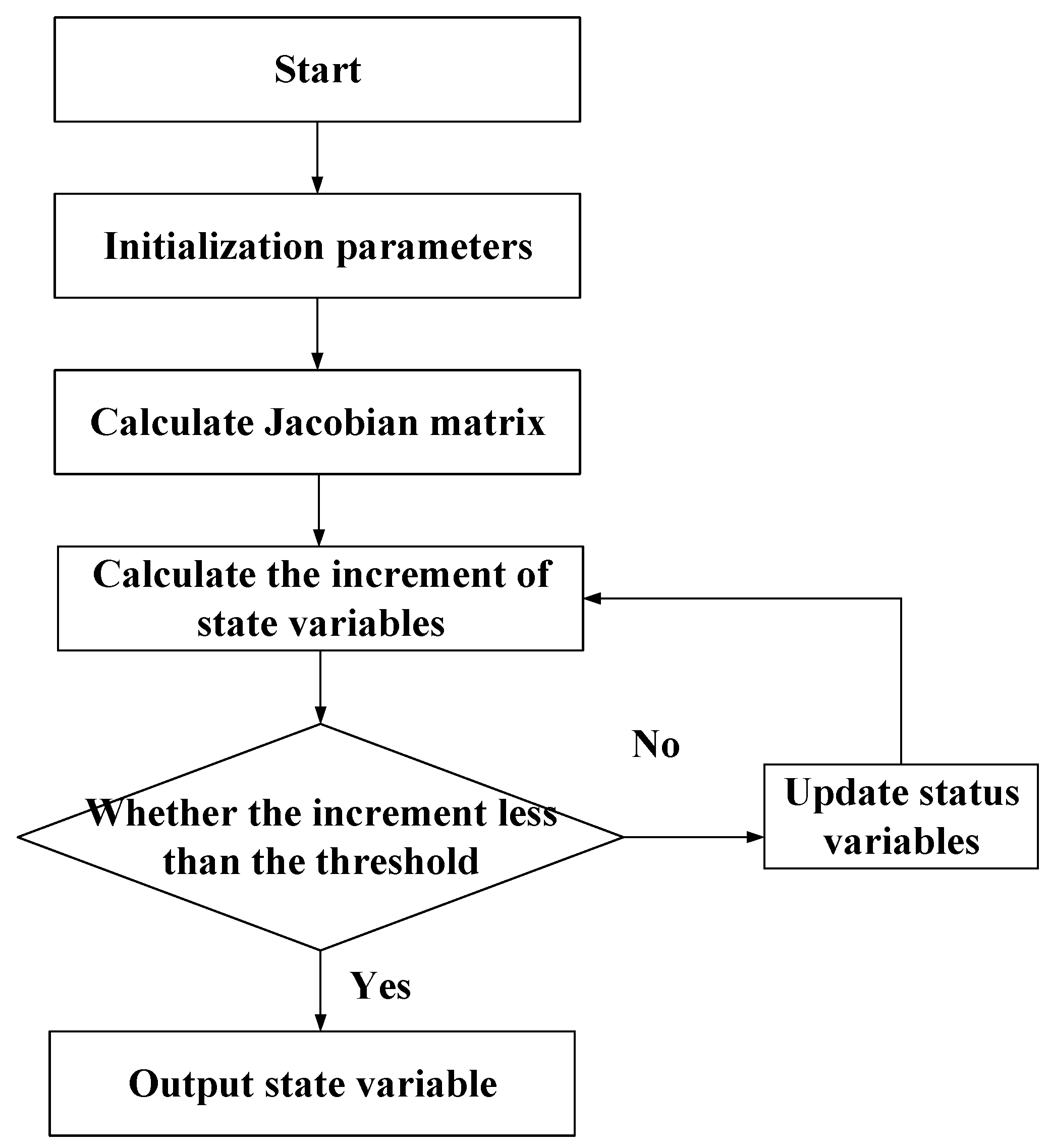
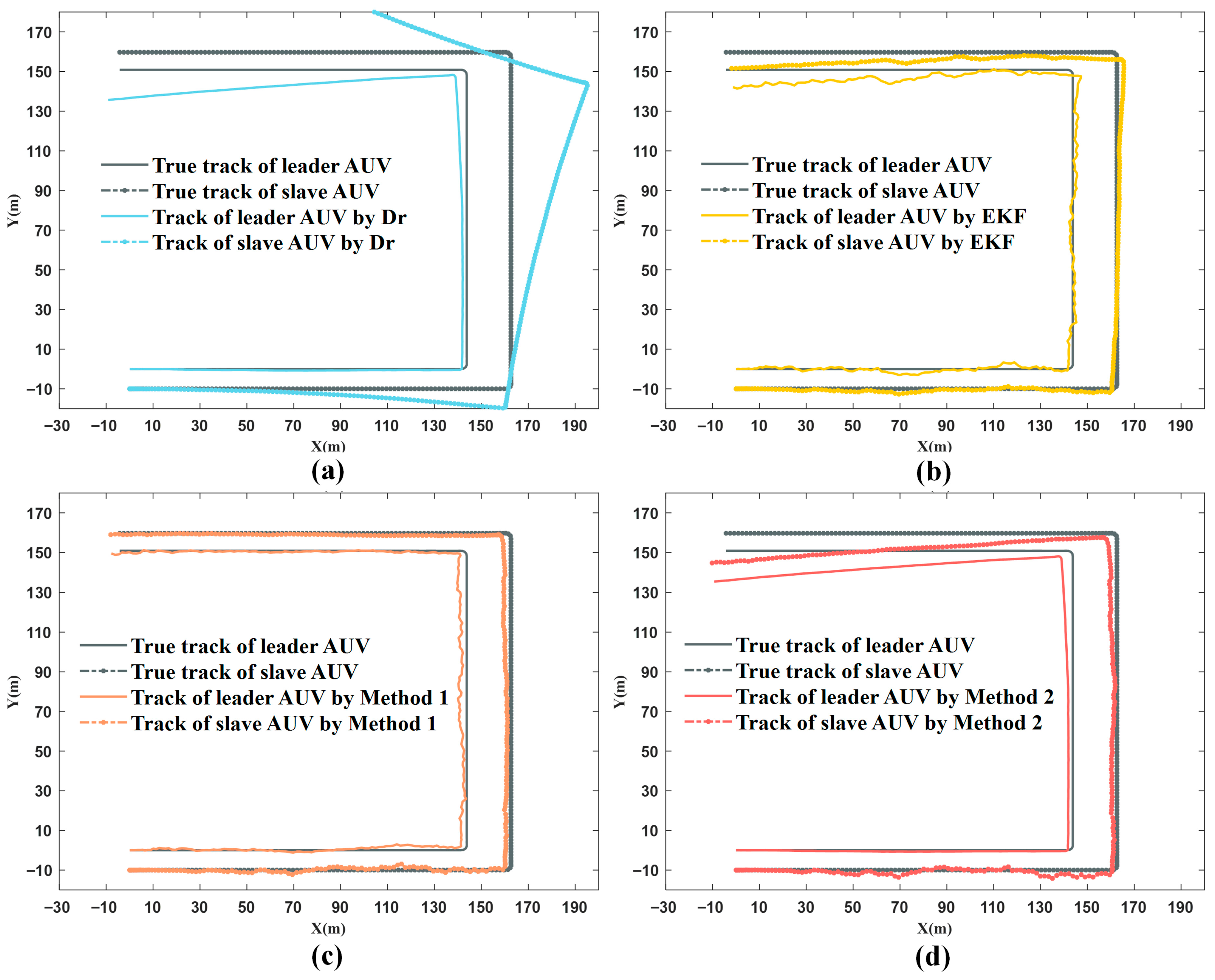
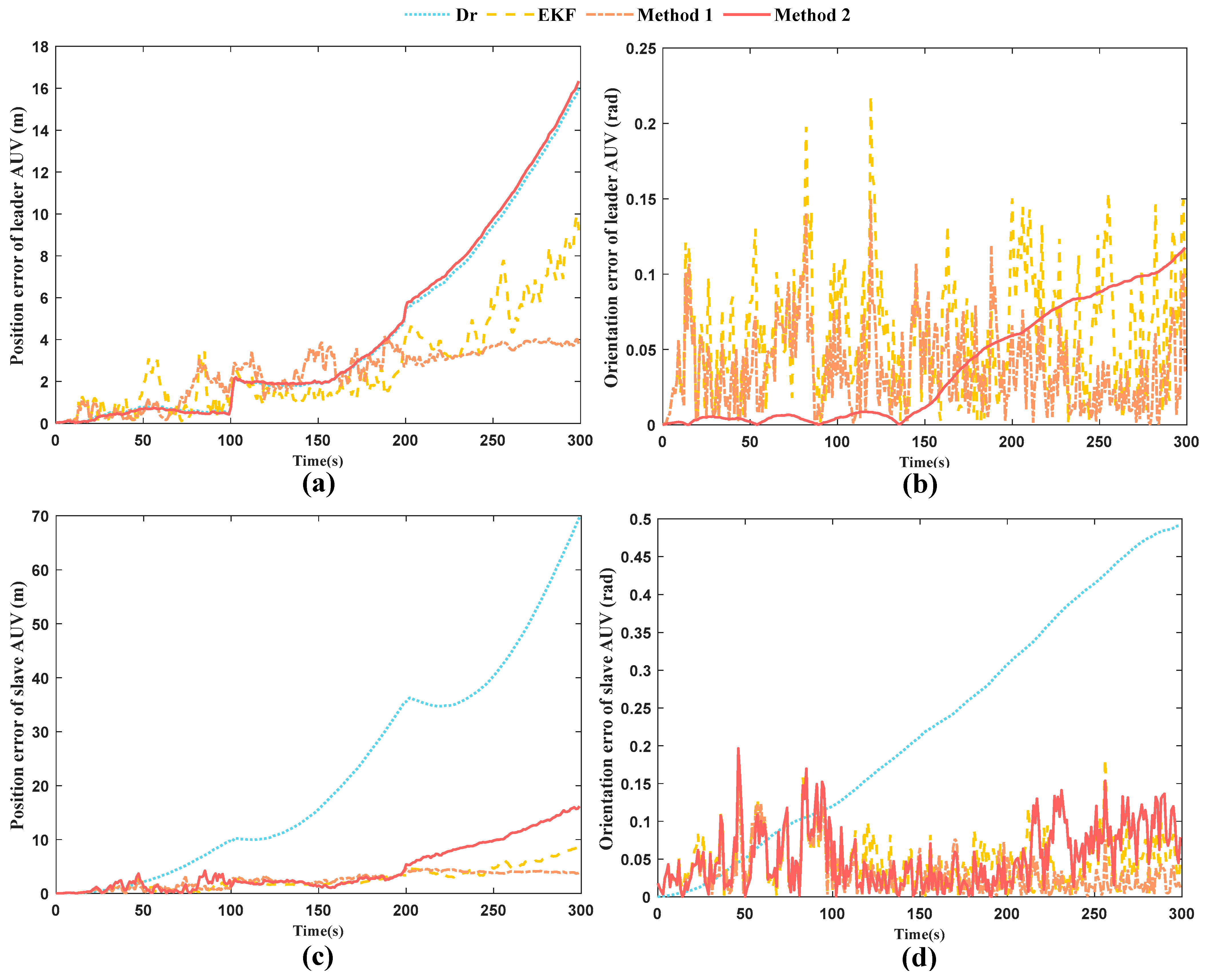
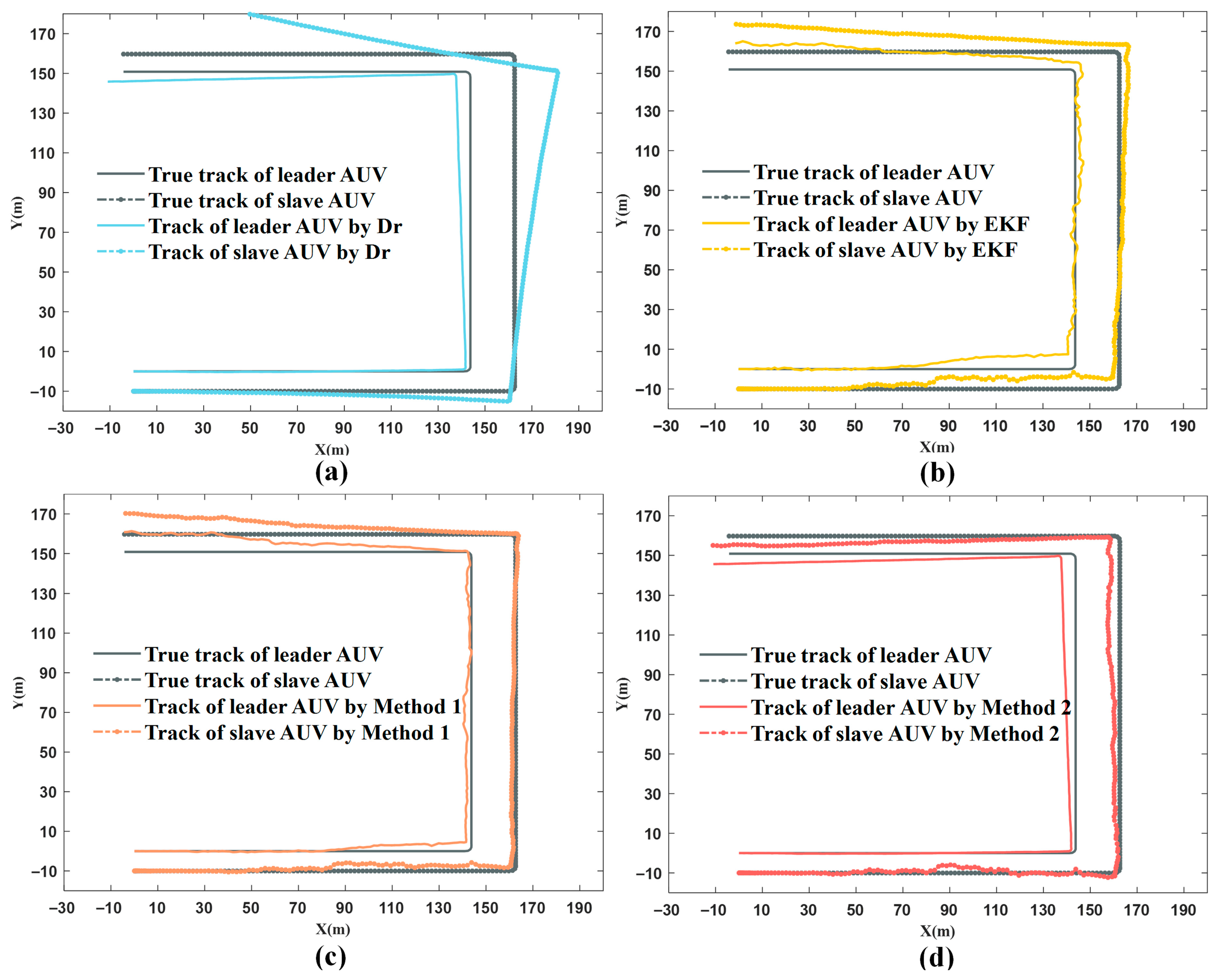
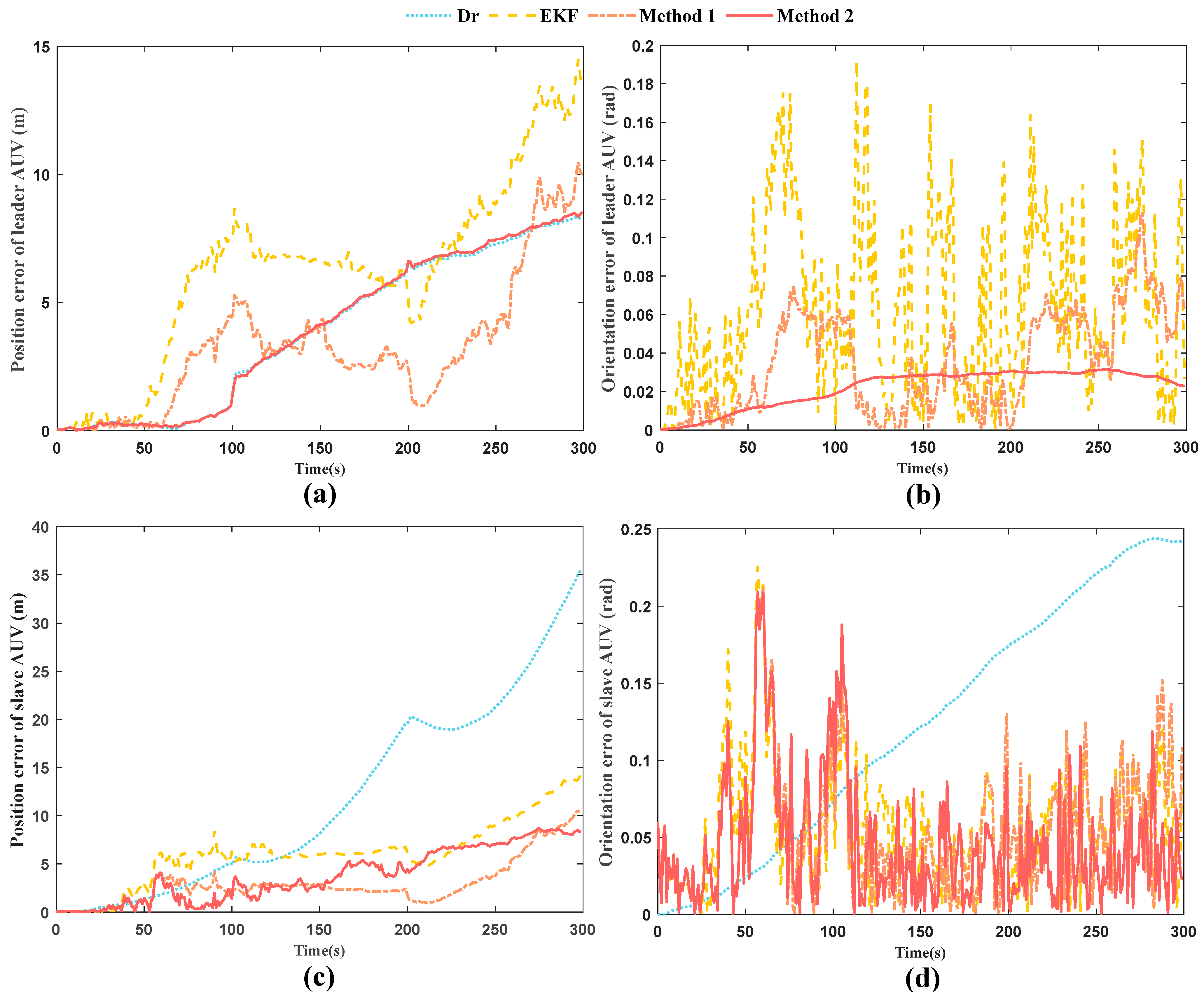
| Description | Symbol |
|---|---|
| Linear velocity in body frame | |
| Angular velocity in body frame | |
| Restoring force and moments | |
| Added mass coefficient | |
| Linear damping coefficient | |
| Quadratic damping coefficient | |
| Cross-flow damping coefficient | |
| Control coefficients | |
| Propulsion Coefficients |
| Equipment | Parameter | Value |
|---|---|---|
| IMU1 | Constant Bias of Gyroscope | |
| Angular Random Walk | ||
| Constant Bias of Accelerometer | ||
| Velocity Random Walk | ||
| Update Frequency | ||
| IMU2 | Constant Bias of Gyroscope | |
| Angular Random Walk | ||
| Constant Bias of Accelerometer | ||
| Velocity Random Walk | ||
| Update Frequency | ||
| DVL | Velocity Measurement Noise | |
| Update Frequency | ||
| Sonar | Range Measurement Noise | |
| Bearing Measurement Noise | ||
| Update Frequency |
| The Algorithms | Description | Position Error of Leader AUV (m) | Orientation Error of Leader AUV (Rad) | Position Error of Slave AUV (m) | Orientation Error of Slave AUV (Rad) |
|---|---|---|---|---|---|
| Dr | RMSE | 6.13 | 0.05 | 29.05 | 0.27 |
| MAXE | 15.98 | 0.12 | 69.69 | 0.49 | |
| EKF | RMSE | 3.51 | 0.07 | 3.37 | 0.06 |
| MAXE | 9.94 | 0.22 | 8.46 | 0.18 | |
| Method 1 | RMSE | 2.67 | 0.04 | 2.86 | 0.04 |
| MAXE | 4.16 | 0.15 | 4.64 | 0.16 | |
| Method 2 | RMSE | 6.31 | 0.05 | 6.40 | 0.07 |
| MAXE | 16.32 | 0.12 | 16.15 | 0.20 |
| The Algorithms | Description | Position Error of Leader AUV (m) | Orientation Error of Leader AUV (Rad) | Position Error of Slave AUV (m) | Orientation Error of Slave AUV (Rad) |
|---|---|---|---|---|---|
| Dr | RMSE | 4.9 | 0.02 | 15.33 | 0.15 |
| MAXE | 8.38 | 0.03 | 35.60 | 0.24 | |
| EKF | RMSE | 7.19 | 0.08 | 6.92 | 0.07 |
| MAXE | 14.51 | 0.19 | 14.27 | 0.23 | |
| Method 1 | RMSE | 4.11 | 0.04 | 3.76 | 0.07 |
| MAXE | 10.48 | 0.11 | 10.56 | 0.21 | |
| Method 2 | RMSE | 4.97 | 0.02 | 4.73 | 0.06 |
| MAXE | 8.53 | 0.03 | 8.69 | 0.21 |
Disclaimer/Publisher’s Note: The statements, opinions and data contained in all publications are solely those of the individual author(s) and contributor(s) and not of MDPI and/or the editor(s). MDPI and/or the editor(s) disclaim responsibility for any injury to people or property resulting from any ideas, methods, instructions or products referred to in the content. |
© 2025 by the authors. Licensee MDPI, Basel, Switzerland. This article is an open access article distributed under the terms and conditions of the Creative Commons Attribution (CC BY) license (https://creativecommons.org/licenses/by/4.0/).
Share and Cite
Liu, J.; Bu, X.; Wu, C. A Novel Cooperative Navigation Algorithm Based on Factor Graph and Lie Group for AUVs. J. Mar. Sci. Eng. 2025, 13, 1988. https://doi.org/10.3390/jmse13101988
Liu J, Bu X, Wu C. A Novel Cooperative Navigation Algorithm Based on Factor Graph and Lie Group for AUVs. Journal of Marine Science and Engineering. 2025; 13(10):1988. https://doi.org/10.3390/jmse13101988
Chicago/Turabian StyleLiu, Jiapeng, Xiaodong Bu, and Chao Wu. 2025. "A Novel Cooperative Navigation Algorithm Based on Factor Graph and Lie Group for AUVs" Journal of Marine Science and Engineering 13, no. 10: 1988. https://doi.org/10.3390/jmse13101988
APA StyleLiu, J., Bu, X., & Wu, C. (2025). A Novel Cooperative Navigation Algorithm Based on Factor Graph and Lie Group for AUVs. Journal of Marine Science and Engineering, 13(10), 1988. https://doi.org/10.3390/jmse13101988





